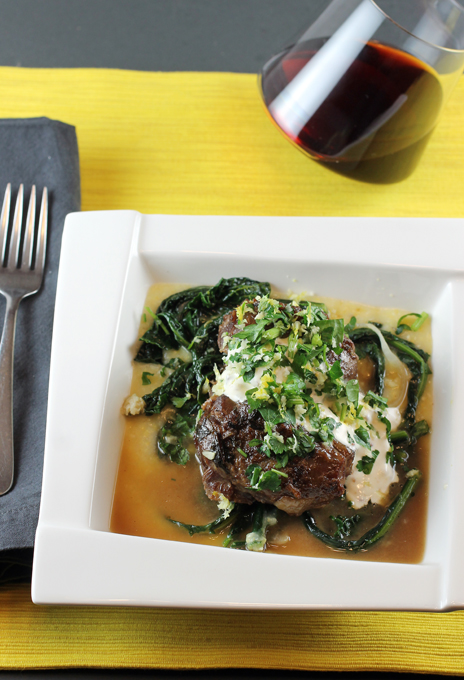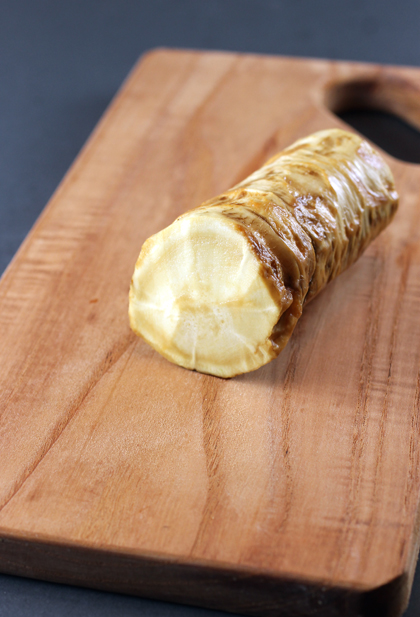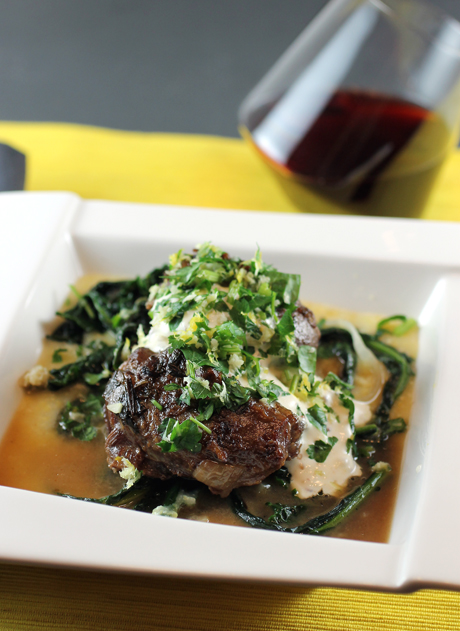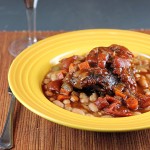A Pork Cheeks Pig-Out
I’m not going to lie: This recipe takes a commitment.
To spend many hours cooking. To be willing to use a load of pots and pans, as well as multiple burners plus the oven. And to go the extra step of actually sourcing some pork cheeks in the first place.
If you do all that, though, you will be richly rewarded. Not only with a comforting dish boasting layer upon layer of flavors. But with the pleasure of enjoying a unique cut of pork, which when braised patiently, results in meat so succulent, sweet and tender that it can be eaten with a spoon.
“Pork Cheeks with Polenta, Mustard Cream and Horseradish Gremolata” is from the new “The A.O.C. Cookbook” Alfred A. Knopf), of which I received a review copy. The book is by Suzanne Goin, chef-owner of Lucques and A.O.C. restaurants in Los Angeles. Lucques is all about sharing food and wine with friends at the table over small plates and family-style dishes.
If you already have cooked from Goin’s first cookbook, “Sunday Suppers at Lucques” (Knopf), you know her recipes are lengthy because of the meticulous directions she gives. As a result, you approach the book knowing that if you take the time, you can’t fail because she’s described the dish step by step with utmost care.
After falling head over heels with beef cheeks when I cooked them recently, I couldn’t help but zero in on her recipe for pork cheeks. Of course, there was that pesky question of how to get my hands on those piggy cheeks. John Paul Khoury, corporate chef of Preferred Meats, Inc. in Oakland, became my go-to source. After having read my blog post on beef cheeks, he said I absolutely positively had to try cooking pork cheeks next.
So Preferred Meats, which sells wholesale to top Bay Area restaurants, including SPQR in San Francisco and Hopscotch in Oakland, offered to sell me pork cheeks at an unbelievable wholesale price. Not just any pork cheeks, either, but ones from heritage-breed Durocs from the Beeler family’s ranch, which has been raising pigs for five generations in Iowa.
Preferred Meats is now extending that same offer to Food Gal readers: Yes, Duroc pork cheeks for about $2.39 pound. The catch, however, is that you have to order a minimum of 10 pounds (two 5-pound bags total). And you have to pay UPS shipping, which is nearly equal to the total cost of the pork. Either that or arrange to pick up the cheeks at Preferred Meats’ Oakland warehouse. The cheeks come frozen, so just stick the extra bag in the freezer for later like I did. If you’re interested, call (510) 632-4065 to order.
Pork cheeks are not white in color like a pork chop or a pork loin, but dark almost like lamb. If you are using a 5-pound bag of pork cheek from Preferred Meats to make this recipe that calls for 3 pounds of cheeks, just increase the amount of braising ingredients to nearly double the amount stated below.
Once you’ve got the cheeks, you’ve also got to acquire the veal stock and fresh horseradish root necessary for this dish. Look for them at a gourmet grocer, such as Draeger’s stores on the Peninsula, where I easily found both.
Now the real work begins. It’s not hard or complicated work. It just involves many steps. You have to marinate the cheeks overnight. The next day, sear them before adding them to a large Dutch oven with the rest of the braising liquids, vegetables and aromatics. Allow it to braise away in the oven for 2 1/2 hours. Easy enough. But then you have to blanch the kale, spread it out to cool, then saute it gently with rosemary and olive oil. Next, you make the garlic-horseradish-parsley-lemon gremolata. Then, stir together the mustard-creme fraiche sauce. And don’t forget to start the polenta, which takes more than an hour to make. It’s definitely longer than I usually allow for making polenta, but Goin’s method results in an extremely creamy polenta because it allows time for the cornmeal to really soak up the water.
Once the cheeks are done, remove them one by one to a baking sheet to give them one last blast in the oven to brown them. Meantime, reduce the braising liquid on the stovetop.
After all that is said and done, spoon the polenta onto shallow bowls or one big serving platter. Top with the kale, then the pork cheeks, next the creme fraiche sauce, and lastly the gremolata.
If you aren’t in need of a nap by then, sit down and take your first bite. The pork cheeks are beyond tender, yet so meaty with no extraneous bone or tendons to mar its texture. The polenta is the perfect accompaniment, as it’s equally spoonable and soaks up all the flavors. Blanching the kale before sauteing it leaves the leaves a vivid green and much more tender than sauteing alone would do. The mustard-creme fraiche adds a luxuriousness, and the gremolata gives tiny little hits of citrus and nose-clearing heat. Each bite is different. And each gives you more complexity to admire and relish.
You can braise the cheeks the day before serving, then make the rest of the components the day you plan to serve the dish. That would help break up the process and make it a little less daunting.
Or you can just take a deep breath, gird yourself and go for it all in one shebang.
Either way, you’ll be patting yourself on the back on a cheeky job well done.
Pork Cheeks with Polenta, Mustard Cream and Horseradish Gremolata
(Serves 6)
3 pounds cleaned pork cheeks
6 cloves garlic, smashed, plus 1 teaspoon minced garlic
1 tablespoon plus 1 teaspoon grated lemon zest
1 tablespoon thyme leaves
1 tablespoon rosemary leaves, plus 1 small sprig rosemary
3 tablespoons grape-seed or canola oil
1 cup diced onion, plus 1 cup thinly sliced onions
1/2 cup diced carrots
1/2 cup diced celery
1 cup sherry
6 cups veal stock
6 sprigs flat-leaf parsley, plus 1/4 cup chopped flat-leaf parsley
1 pound cavolo nero or other kale
1/4 cup extra-virgin olive oil
1 chile de arbol, crumbled
1 tablespoon whole-grain mustard
1 tablespoon Dijon mustard
3/4 cup creme fraiche
2 teaspoons finely grated fresh horseradish
1 recipe Polenta (recipe follows)
Kosher salt and freshly ground black pepper
Season the pork cheeks with the smashed garlic, 1 tablespoon lemon zest, the thyme, and rosemary leaves. Cover and refrigerate overnight.
Take the pork cheeks out of the refrigerator an hour before cooking, to bring them to room temperature. After 30 minutes, season the cheeks on both sides with 2 tablespoons salt and 1 teaspoon pepper. Reserve the garlic and any excess herbs.
Preheat the oven to 325 degrees.
Heat a large saute pan over high heat for 2 minutes. Pour in the grape-seed oil, and wait a minute or two, until the pan is very hot and almost smoking. Place the cheeks in the pan, and sear them for about 8 minutes, until caramelized and nicely browned on both sides. Transfer the cheeks to a braising pan that has a tight-fitting lid.
Turn the heat down to medium, and add the diced onion, carrot, celery, and any reserved garlic and herbs. Stir with a wooden spoon to scrape up all the crusty bits in the pan. Cook for 6 to 8 minutes, until the vegetables just being to caramelize. Add the sherry, turn the heat to high, and reduce the liquid by half.
Add the stock, and bring to a boil. As soon as it comes to a boil, pour the liquid over the cheeks, scraping any vegetables that fall on the meat back into the liquid. The stock mixture should almost cover the cheeks. Tuck the parsley sprigs among and around the cheeks. Cover tightly with aluminum foil and a tight-fitting lid. Braise in the oven for about 2 1/2 hours.
To check the meat for doneness, carefully remove the lid and foil (watch out for the hot steam), and pierce one of the cheeks with a paring knife. When the meat is done, it will yield easily.
While the cheeks are cooking, blanch the cavolo nero in rapidly boiling water for 2 minutes. Drain, and cool the greens on a baking sheet. When they have cooled, squeeze out the excess water with your hands.
Heat a large pot or Dutch oven over medium heat for 2 minutes. Pour in the olive oil, add the rosemary sprig and crumbled chile, and let them sizzle in the oil about a minute. Turn the heat down to medium-low, and add the sliced onion. Season with 1/2 teaspoon salt and a few grindings of black pepper. Cook for 5 to 7 minutes, until the onion is soft and starting to color slightly.
Add the cavolo nero, stirring with a wooden spoon to coat the greens in the oil. Season with a heaping 1/4 teaspoon salt and cook the cavolo over medium-low heat for about 15 minutes, stirring often, until tender but still green.
Stir the mustards and creme fraiche together in a small bowl, and keep chilled.
Chop the minced garlic, remaining 1 teaspoon lemon zest, the chopped parsley, and the horseradish together until very fine, to make the gremolata.
When the pork cheeks are done, turn the oven up to 400 degrees. Transfer the cheeks to a baking sheet, and return them to the oven to brown for about 8 minutes.
Strain the broth into a saucepan, pressing down on the vegetables with a ladle to extract all the juices. If necessary, reduce the broth over medium-high heat for about 5 minutes, to thicken it slightly.
Spoon the hot polenta into six shallow bowls, arrange some cavolo nero on the polenta, and place the pork cheeks on top. Ladle the broth over the cheeks, and let it pool in the bowl. Spoon the mustard cream onto the cheeks, and sprinkle the gremolata over the whole dish.
Polenta
(Serves 6)
1 cup medium-grain polenta (Bob’s Red Mill recommended)
3 tablespoons unsalted butter
Kosher salt
In a heavy bottomed pot, bring 5 1/2 cups water and 1 tablespoon salt to a boil over high heat. Add the polenta slowly, whisking continuously. Turn the heat down to low, and continue cooking for another 20 minutes, whisking often. Add another 1/2 cup water and cook 1 more hour, whisking often and adding 1/2 cup was as needed, about every 20 minutes. The flame should be low, so that the polenta is barely simmering. As you whisk, make sure that you reach the bottom of the pan to prevent the polenta from scorching. I like to use a rubber spatula to scrape the bottom and sides of the pot.
Whisk in the butter, and taste for seasoning. Even when the polenta is finished, you might sense it thickening up a little. If so, add a little more water and whisk to get the right consistency. If you’re not serving right away, cover the pan tightly with plastic wrap to keep the polenta from thickening or losing moisture. If necessary, rewarm over low heat before serving.
Wine Recommendation From Co-Owner Caroline Styne: This is one of those dishes that can be paired with either white or red wine. The polenta and herby gremolata take this pork recipe in an Italian direction, and because of the overall brightness here, I would opt for wines from a cooler region, like Piemonte, where the morning fog allows the grapes to maintain vibrant acidity. If you opt for white, the Langhe region produces really elegant, high-toned Chardonnay that will emphasize the creaminess of the polenta and sweetness of the meat. If you prefer red, Nebbiolo is ideal: it has bright red fruit notes of cranberry and red currant that will marry with the mustard and horseradish and balance the weight of the recipe as a whole.
Recipes from “The A.O.C. Cookbook” by Suzanne Goin
For Comparison’s Sake: Braised Beef Cheeks
Another Suzanne Goin Recipe: Lucques Grilled Pork Burger








A fabulous dish! I really have to try pork cheeks soon…
Cheers,
Rosa
Pingback: Food Gal » Blog Archiv » Beef Cheeks, Baby!
It must have been fun to write “pork cheeks pig-out!” This looks like an amazing recipe. I’ve had pork cheeks, and they’re wonderful. But never cooked with them. And I like long, complicated recipes, so this is for me. Thanks.
Congratulations on taking on such a monumental effort in making dinner! 😉 The results look just like a restaurant dish. So, wonder if it would be much different if you just went with beef cheeks?
Carolyn, This does look like a pain to make but I have word into Preferred – that is a great price especially for quality pork. ps Where’d you find beef cheeks around here?
That looks beyond amazing. I’m sure it was worth all the effort!
Carrie: I got the beef cheeks from Prather Ranch(http://pratherranch.com/). They usually have the beef cheeks at their Ferry Building store in SF. Otherwise, they often have them at their farmers market stands, too. But for the farmers markets, it’s best to order ahead and tell them which farmers market stand you want to pick them up at, since they don’t always have them there.
Ben: You could probably use beef cheeks in this dish, too. The flavors would still work, what with the beef standing up quite well to the big flavors of the mustard and horseradish. Or pork shoulder would be a fine substitute, too.
Carolyn, what a delicious looking dish. Just one look makes me want to have some. Thanks for sharing this 🙂
I have never had pork cheek, but can imagine how tasty it is…yes, I would dig in with a spoon for sure if I had this dish in front on me…
Hope you are having a great week Carolyn 😀
One of the things I miss about living in a large city is your access to quality ingredients. I think I’ll try your delicious looking meal using pork shoulder…even though it won’t be as good I’m sure.
OMG!!! I have never cooked anything like this. But yours looks amazing. Are the pork cheeks more tender than beef cheeks?
Rae: They both cook up extremely tender, but if I had to give the edge in tenderness to one, it would probably be the pork cheeks. I could eat those with a spoon, whereas with the beef cheeks, I think I still needed a fork. 😉
i’ve never actually eaten pork cheeks or even seen them on a menu, but i love polenta and mustard with pork! looks like a useful recipe!
I love braised pork cheeks braised in beer, we eat it in Belgium here this way. This recipe sounds even amazing. Xx
Yum Yum yummmm. 😊
Pingback: A Food Writer Prepares Duroc Pork Cheeks | atmytableblog